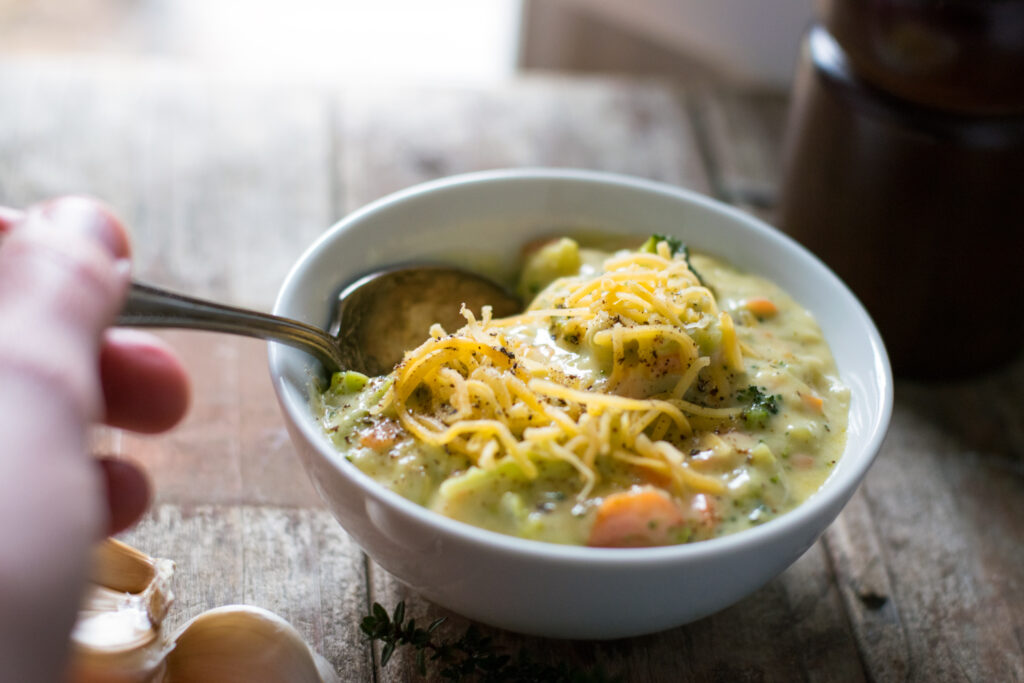“Only the pure in heart can makea goodsoup.” – Ludwig van Beethoven.
Soup
My mother made homemade soup every Sunday night.
The soups changed with the seasons and with the ingredients available. She never used a recipe.

Chicken or turkey for dinner always signaled that there would be homemade chicken or turkey soup in the not so distant future, made from boiling the bones all day in a homemade vegetable stock. Any scraps of meat would be cleaned off the bones and added back in, while the bones themselves cooked into bare, bleached leftover scraps, leaving all their flavor behind in a rich, meaty broth shimmering with goodness and a thin, gossamer layer of glistening chicken fat. The entire house smelled like comfort; nothing was wasted.
In the spring her soups came alive with the first bright, hopeful sprouts to poke their heads out of the garden from under the snow. After a long winter it was glorious to see our soups brimming with fresh green onions and little pops of fresh green peas. Easter meant ham, which meant my favorite soupРleftover ham and rice made by boiling the ham bone for hours and combining the savory broth with vegetables, milk, cheese, and rice. I can still remember the intoxicating smell of onions, celery, and carrots saut̩ing in a modest bit of butter and olive oil on the back of the stove. My mom relied heavily on vegetables for flavorРshe seldom used much butter or salt. The food she prepared was pure, with the essence of the vegetables coming through loud and clear. She cooked with the gardenРusing what was in season because it was available, but also because it was the best tasting and freshest. She was farm to table long before it was considered chic to be so. She simply cooked with the best of what she had, and she learned to honor the ingredients and elevate the most humble, simple flavors through her skill.

She would probably blush if she heard me praise her talents like this– she would say “there’s nothing special about making soup out of leftovers.” But that’s where she would be wrong. Making soup is a complex, nuanced skill that is as much art as it is science. To cook without a recipe is to cook, as the French would say, au pif— or “on the nose.” It is using one’s senses, rather than a textbook, to guide. This type of cooking can be observed only in experienced, confident cooks who have been tasting and creating meals all their lives, to the point where their instincts are more skilled than the book.
No food was ever wasted in our house. We always had a big garden, and we all learned to help weed, harvest, and take care of it. We canned, pickled, processed, blanched, and pureed everything you can imagine. Where some people picture having a kitchen garden where they can skip merrily out into a sun-soaked afternoon with a wicker basket swinging lazily on their arm, collecting a snip of this and a snip of that for dinner whenever they feel like it, the reality is much different. In a garden as large as ours was, designed to feed our family of 5 not only through the summer, but also through the colder months until the next garden would start producing again, it was all hands on deck once the plants started to ripen.

We learned to harvest our cold weather vegetables like lettuce, broccoli, and peas, fast and early before the summer sun became too warm and caused them to bolt and harden into inedible, dried up stalks. We savored the first tender, mild green onions, knowing that the longer they were in the ground the stronger their taste would get until they developed a nose-watering, eye-popping strength by about mid summer. I have never known a store bought onion to taste as strong as those onions we grew; I don’t know why. Our onions came out of the earth as if they were harboring a grudge from being awakened, ready to challenge your stomach to a duel to the death (we always won). It never took very many of them to flavor a dish– 1/4 cup of those “Rebel Onions” would flavor an entire roast. What they lacked in size they made up for in POWAH.
When summer started in earnest and left behind the dangers of overnight frost we put in the rest of the garden– tomatoes, peppers, squash, corn, regular and sweet potatoes, and green and lima beans. It became a battle with the local wildlife to protect our tender shoots while they matured– we placed overturned milk jugs over the plants while they were small and then sprinkled their leaves with cayenne pepper when they outgrew their milky nurseries. It was not uncommon to come outside in the morning and see a deer grazing contentedly on the tender broccoli sprouts. Ironically, the deer and rabbits especially loved peas and lettuce, but they stopped bothering them as the weather grew warmer and the vegetables grew tough and spindly. I suppose that even the animals wanted only the best selections from their free vegetable buffet! I remember one particular rabbit who seemed to actually have a taste for cayenne after his initial shock, who would not only eat the leaves sprinkled with it, but would also come back and search for fallen leaves sprinkled with pepper so that he could lick the “hot sauce” off of it. I never saw him again after that year so perhaps he moved to Mexico and is enjoying hot pepper fire on his rabbit tongue to this day.

Summertime brought soups in every flavor, type, and color. Our Sunday soup pot was wild with a ménage of color– pops of green from the beans and the peppers, white and yellow corn from the stalks that were hopefully “knee high by the fourth of July,” blushing red tomatoes and shy, pale lima beans. We had two soups very often in the summer– vegetable soup (one of my favorites), and ham and green beans– really just a great big pot of green beans, one potato cut into tiny chunks, and a tiny bit of ham for flavoring that simmered all day and was ready for us when we tromped into the house in the evening after working outside all day, tired and hungry. Nothing was better than green beans picked just that day and a piece of homemade bread to sop up the ham juice. Everyone got a taste of the meat without having very much of it. To this day, ham and green beans is one of my favorite meals and the quintessential “summer supper,” served with strawberry shortcake for dessert. Sometimes the shortcake and strawberries would be the entire meal, the luscious scent of strawberries still warm from the sun seeming to capture the very essence of the sunshine and holding it for a moment, just for us to enjoy.
As summer deepened into late summer, tomatoes came into season with aggressive force. I both loved and hated tomato season because there are few things I love more than a big, juicy heirloom tomato just picked and still warm from the sun. I love their strange shapes and colors– their big, sweetly rotund appearance. I love their beautiful POW POW! of tomato flavor (something their sad grocery store cousins sorely lack) and their crazy streaks of color. I love their smell– earthly and insistent. I just love them.
But I don’t love 50 billion of them at once. I remember going out to the garden every day with 5 gallon buckets in each hand and filling them, then trudging wearily back to the house where we would wash tomatoes (again!), remove their stems, and prep them for processing. Great big stew pots bubbled furiously in the basement (the only place it was cool enough to have the ovens raging so hot in the middle of August), their sachets of spices floating merrily on top of the frothing, ruby red liquid. The whole house smelled like spaghetti sauce for days on end.

Even though it was a lot of work, with tomato season came a few more of my favorite soups– cream of tomato soup and chili. We would make these soups in huge batches and can them for winter, eating as our supper whatever leftover soup didn’t fit into the jars. If you have never tasted real tomato soup and have relied on Campbell’s for your tomato soup education, then let me urge you to try the homemade variety sometime. Canned and homemade tomato soups are as different as night and day– and nearly as illuminating. Homemade tomato soup is a breath of summer– the pungent scent of tomatoes and a whiff of their heady, proud stems basking in the sun. It is fresh cream and spices and herbs picked that day, straight from the herb garden. It is olive oil and the taste of sunshine. It is life.
Homemade chili is always delicious, but paired with homegrown tomato stock it is a wonderment. We grew up eating mostly deer meat rather than beef, so venison was generally the basis of my Mom’s chili. But of course any meat will do– turkey, venison, beef– I have even made chili with leftover chopped up chicken breast. And when you add in homemade tomato stock the ingredients truly shine. There is nothing like homemade chili with ingredients fresh from the garden– nothing in the can comes close. Since the tomatoes have never known the inside of a can, they don’t have that tinny, acidic, “aluminum” aftertaste. They taste like summer– like hard work and skinned knees and bare feet and freckles and tire swings and smiles with your front teeth missing. They taste like home.

Fall brought along the winding down process of the main garden and the planting of the cold weather garden. We dug potatoes as the vines died back, delighting in finding them in the dirt almost as if we were digging for gold. We planted the second crop of root vegetables– onions, carrots, parsnips, potatoes. We harvested the squash and brought them down to the basement to sleep peacefully in the potato bin, cool and dry on newspapers to be used as needed. The potatoes didn’t seem to mind having roommates, as long as they were quiet.
Fall soups were always beautiful and golden brown colors. My mom loved to make butternut squash and sweet potatoes a mainstay in her fall soups. Often we saw green islands of torn up kale in these varieties, along with root vegetables simmered all day to encourage them to give up some of their delicate flavor to the broth.
Soon apple season was upon us, and then it was applesauce, apple butter, apple pie, apple pie filling being canned. We had apples in our soup sometimes– pork based soups with apples and onions, and kale if we had any. The weather was cold, and the furnace kicked on every night. We could see our breath in the mornings. Time was growing short to gather the rest of the garden before the first hard frost ruined it. We brought the remaining green tomatoes into the house to finish ripening on the windowsill. Tomatoes on newspapers lined every surface in the kitchen, slowly being used up as they blushed pink and then red. The plants were finally “zapped,” as we said, and we cleared them out of the garden and ground them up for compost for next year.

When winter began in earnest we covered the cold weather vegetables with a layer of leaves raked from the backyard. No one threw leaves away in garbage bags like today– we would never throw away such good compost! We mulched our flower beds with the ground up leaves and covered everything in the garden up nice and snug to protect the root vegetables over the winter. We would go out and dig down under the “comforter” whenever we needed an onion or a carrot. The ground was frozen but down where the vegetables were it wasn’t, and we harvested root vegetables as needed until they ran out. There were also onions and garlic hanging from nails in the ceiling in the basement, drying in golden bunches until we needed them. Apples, potatoes, and squash nestled in the potato bin, quiet and cool. Glittering rows of jars lined the shelves after a summer of hard work canning them. It was time to sit back and enjoy the fruits of our harvest, literally.
Winter soups were much like fall soups, with the exception that they relied heavily on canned and preserved ingredients from our summer harvest. The meals became more cozy and savory– a Sunday pot roast meant vegetable beef soup or beef stew the next day, bubbling merrily on the back of the stove, making the whole house smell warm and cozy. Chicken noodle soup appeared after a roast chicken dinner, and tomato soup with grilled cheese sandwiches was (and still is) one of my very favorites. The butternut squashes graced many winter soups, as did the other “hero” root vegetables– the ones that remain good for months in their quiet root cellar bed, allowing you some much needed color and freshness during the drabness of winter. Carrots dug in the middle of winter were sweeter, somehow. I don’t know if they actually were sweeter, or whether it just seemed that way because they were one of the few things left in the garden. The apple “faces” that we carved each year and salted before hanging from strings started to pucker up and look like old lady faces. Each year we each carved one apple face each and enjoyed seeing their faces shrivel and age into lifelike grandparent faces before our eyes.

A favorite winter soup was potato soup– its richness accented by onions, celery, garlic, carrots, potatoes, and some type of savory meat, if we had some. Sometimes Mom added rice if we had any left over, and no rice if she didn’t. Mostly we added ham, but sometimes it was deer sausage or kielbasa, a type of Polish sausage. Her potato soup was always a favorite of my Dad’s, and she never made it the same way twice. I remember my mom opening the fridge and “shopping” through it– grabbing leftovers and things she wanted to use up before they went bad, and saying to herself, “Now what can I do with these?” She always managed to make something wonderful, somehow marrying all those flavors together into something delicious. She had her own show “Chopped” before the show even existed.
Sunday nights after church we would come home and have soup. Mom made it out of whatever she had left, and whatever was available. She usually made homemade Stromboli as well, also using whatever was left or whatever she needed to use up. To this day soup and Stromboli reminds me of Sunday evenings sitting around a warm, cozy table while the wind and snow whip menacingly around the eaves outside. It instantly takes me back to a place of warmth, comfort, and family.
And that’s what it’s all about, isn’t it? Soup may not be the most exciting or the top gourmet meal, but everyone has a favorite recipe. Every family has a memory of sharing a crock pot of chili at the Super Bowl, or sitting down to a steaming bowl of chicken noodle soup when sniffling and cold, and instantly feeling warmed from the toes to the nose. Everyone makes it differently; some make it from scratch, and some make it from a can, but both bring coziness, normalcy, comfort.

I watched my Mom for years and helped her in the kitchen. I learned how to season by taste, rather than by recipe. Now I don’t use a recipe for my soup, either. I find myself reaching for leftovers in the fridge and making soup out of them. I find myself yearning for the scent of chicken and onions and garlic simmering softly on the back of the stove when the skies start to get wet and dreary. I crave a bowl of steaming goodness when the weather is raw and uninviting and cold. I make soup when I am sad. I make soup to comfort others. I make soup because it is comfort. Soup is family. Soup is love.
This week my 8 year old wanted to help in the kitchen. We got out the onions, garlic, celery, carrots, and potatoes. “What are we making Mommy?” he asked. “Soup?”
It was the start of greatness.
You did it. And I’m just so proud of you.

Disclosure: This post may contain affiliate links, which just means that we get a few pennies if you purchase through our link. I never recommend products that I don't personally use and love. Thanks!







